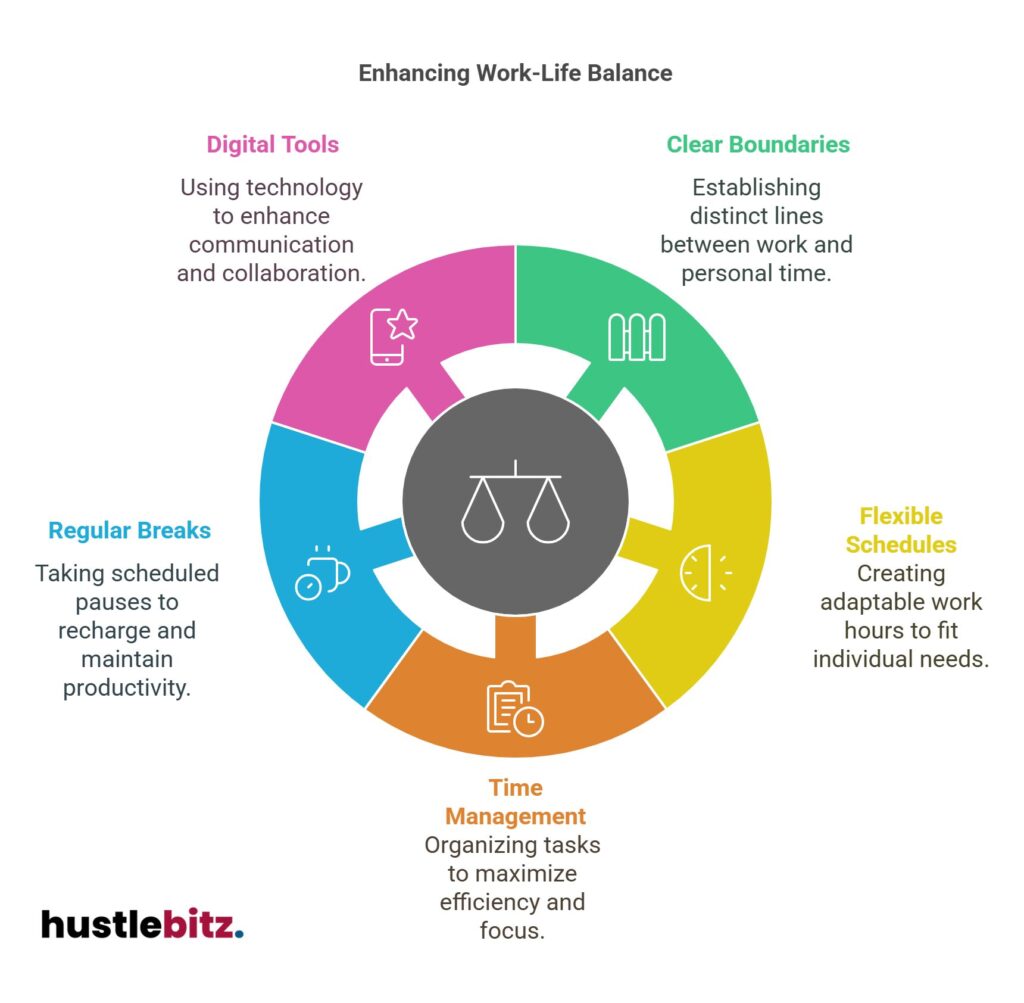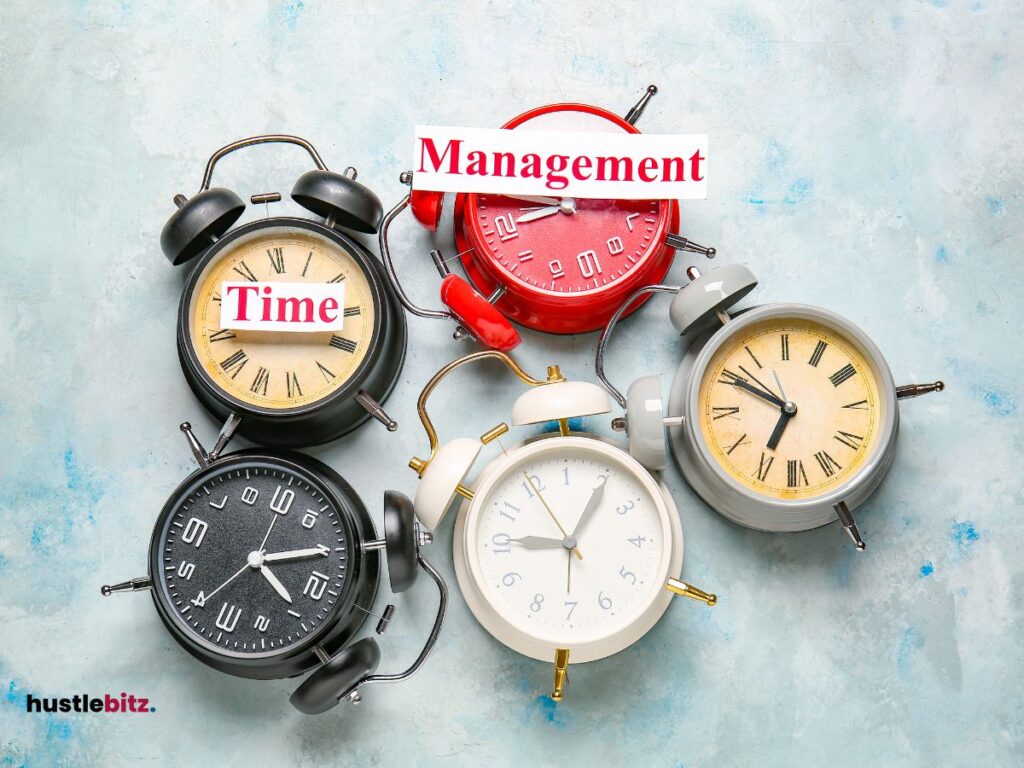Improving productivity without compromising work-life balance involves several strategic approaches. Begin by establishing clear boundaries between work and personal time. Implementing flexible work arrangements can increase autonomy and job satisfaction. Master effective time management through techniques like time blocking and task batching to minimize distractions. Prioritizing urgent tasks alongside regular breaks sustains focus and creativity. Incorporating mindfulness practices can further enhance well-being and performance. Regular check-ins with team members ensure accountability and adaptability. These methods collectively foster an environment conducive to productivity while preserving personal time, allowing you to thrive both professionally and personally. More insights await you on this journey.
Key Takeaways
- Establish clear boundaries between work and personal time to enhance focus and respect for personal commitments.
- Design flexible work schedules that accommodate individual preferences, boosting job satisfaction and engagement.
- Master time management through techniques like time blocking and task batching to prioritize effectively and minimize distractions.
- Incorporate regular breaks and mindfulness practices to sustain productivity and prevent burnout while enhancing overall well-being.
- Utilize digital collaboration tools for effective communication and workload distribution, promoting efficiency in flexible work environments.

Defining Productivity and Work-Life Balance
Productivity refers to the efficiency of an individual or organization in converting resources into outputs, while work-life balance embodies the equilibrium between professional commitments and personal well-being. Understanding these concepts is crucial for fostering a positive workplace culture that enhances employee well-being.
Productivity metrics are essential tools that help organizations assess how effectively their resources are being utilized. These metrics can guide improvements in processes, enabling employees to meet personal goals without compromising their health or personal lives.
In today’s working environment, particularly with the rise of remote work, achieving work-life harmony has become increasingly challenging. Employees often find it difficult to separate their professional responsibilities from personal activities, leading to potential burnout. Encouraging practices like digital detox—periods where employees disconnect from technology—can significantly improve mental health and overall productivity.
A supportive workplace culture that values both high performance and employee well-being fosters a sense of belonging and motivation. Organizations that prioritize work-life balance not only attract top talent but also retain them by creating a sustainable environment.
Establishing Clear Boundaries for Better Work-Life Integration

To foster a healthier work-life integration, it is imperative for individuals and organizations to establish clear boundaries that delineate professional responsibilities from personal time. In the era of remote work, where the lines between home and office can blur, effective boundary setting becomes essential. This includes creating a workspace design that promotes focus during work hours while allowing personal spaces to function as sanctuaries during downtime.
Effective communication strategies are also crucial. Organizations should encourage employees to communicate their availability clearly, utilizing digital tools to signal when they are off the clock. This not only respects personal time but also fosters an environment where family involvement is prioritized. By openly discussing boundaries, teams can cultivate a culture that values both productivity and well-being.
One effective approach to maintain these boundaries is to adopt a digital detox routine. Designating specific times to disconnect from technology can create mental space, allowing individuals to recharge and engage meaningfully with family and hobbies.
Here’s a summary of strategies for establishing clear boundaries:
| Strategy | Description |
| Workspace Design | Create dedicated workspaces to separate work from personal life. |
| Communication Strategies | Clearly communicate availability to colleagues and family. |
| Digital Detox | Schedule regular breaks from screens to recharge. |
| Family Involvement | Engage family members in discussions about work boundaries. |
Mastering Time Management to Enhance Efficiency

Effective time management is a critical skill that enables individuals to prioritize tasks, minimize distractions, and achieve a balanced workload. By implementing structured techniques such as time blocking and task batching, one can significantly enhance productivity.
Time blocking involves allocating specific segments of time to particular tasks, thus reducing the likelihood of multitasking and improving focus. Meanwhile, task batching groups similar activities together, allowing for more efficient execution and less cognitive switching.
Goal setting is another essential component of effective time management. Establishing clear, measurable objectives provides direction and motivation, ensuring that daily activities align with long-term aspirations. Furthermore, honing delegation skills can alleviate overwhelming workloads. By assigning appropriate tasks to team members, individuals can focus on high-priority responsibilities, thereby maximizing efficiency.
Utilizing productivity tools can also streamline time management processes. Applications and software designed for task tracking and scheduling can provide valuable support in organizing daily responsibilities. Additionally, incorporating focus techniques—such as the Pomodoro Technique—can enhance concentration by breaking work into manageable intervals, interspersed with short breaks.
Energy management plays a vital role in effective time management as well. Understanding one’s peak productivity periods can lead to optimal task scheduling, ensuring that challenging tasks are tackled when energy levels are highest.
Prioritizing Tasks to Maximize Output and Minimize Stress
Prioritizing tasks strategically is essential for maximizing output while minimizing stress in both professional and personal spheres. Implementing effective task prioritization techniques can transform your workload management and enhance productivity. By focusing on what truly matters, you can leverage various tools and methods to streamline your efforts.
Here are three effective strategies to consider:
- Goal Setting Methods: Clearly define short-term and long-term goals to provide a roadmap for your tasks. This helps in aligning daily activities with overarching objectives, ensuring that every effort contributes to meaningful outcomes.
- Workload Assessment Tools: Utilize workload assessment tools to evaluate your current responsibilities. This allows you to identify high-priority tasks that require immediate attention while recognizing items that can be postponed or delegated.
- Decision Making Frameworks: Adopt decision-making frameworks such as the Eisenhower Matrix, which categorizes tasks based on urgency and importance. This structured approach aids in distinguishing between what is critical and what can wait, thereby reducing decision fatigue.
Incorporating these strategies, alongside effective delegation practices and productivity tracking systems, can lead to significant stress reduction. By honing your skills in task prioritization, you not only improve your output but also create a more balanced work-life dynamic.
Emphasizing clarity in your task management will ultimately pave the way for greater satisfaction and achievement in all aspects of your life.
Taking Regular Breaks for Sustained Productivity

Incorporating regular breaks into the workday is essential for maintaining sustained productivity and preventing burnout. Research shows that taking mindful breaks can enhance focus and creativity, ultimately leading to more effective work outcomes. By stepping away from tasks for short periods, workers can recharge their mental and physical energy, ensuring they remain engaged and efficient throughout the day.
Engaging in energizing activities during these breaks is crucial. Options such as short workouts can stimulate circulation and boost endorphins, fostering a sense of well-being that translates into increased productivity. Additionally, a digital detox during breaks allows employees to disconnect from screens, reducing eye strain and mental fatigue. Opting for nature walks can further promote relaxation and clarity, as exposure to natural environments has been shown to reduce stress levels.
Moreover, breaks provide an opportunity to pursue creative hobbies or connect with colleagues, reinforcing social connections that are vital for a supportive work atmosphere. Whether it’s engaging in a quick art project or participating in casual conversations, these interactions can lead to improved morale and collaboration.
Ultimately, the key to effective breaks is their intentionality. By integrating mindful practices into the workday, employees can cultivate an environment that fosters both productivity and well-being, striking a harmonious balance between work demands and personal health. Regular breaks not only serve as a reset but also empower individuals to approach their tasks with renewed vigor and creativity.
Designing a Flexible Work Schedule

Balancing productivity and personal well-being can be further enhanced by designing a flexible work schedule that accommodates individual needs and preferences.
By embracing remote work and hybrid models, organizations can empower employees with the autonomy to choose their working hours according to their personal preferences. This approach not only improves job satisfaction but also fosters a more productive work environment.
To create an effective flexible work schedule, consider the following strategies:
- Utilize Digital Tools: Leverage technology to facilitate communication and collaboration, ensuring that employees can stay connected regardless of their location. Tools like project management software and video conferencing applications can enhance teamwork while allowing for flexible hours.
- Promote Workload Distribution: Encourage employees to adjust their workloads based on peak productivity times. By allowing team members to allocate tasks when they feel most efficient, organizations can optimize performance and minimize burnout.
- Encourage Regular Check-Ins: Schedule periodic meetings to assess progress and address any challenges. These check-ins can help maintain accountability while allowing employees to express their needs and preferences regarding their schedules.
Incorporating these elements into a flexible work schedule will not only support employee autonomy but also lead to a more engaged and productive workforce.
Final Thoughts
Balancing productivity with work-life harmony requires clear boundaries, effective time management, and regular breaks to sustain focus and well-being. Embracing flexible work schedules and leveraging technology further enhances efficiency while respecting personal commitments. By continuously refining these strategies, you can achieve professional success without compromising your personal life.




